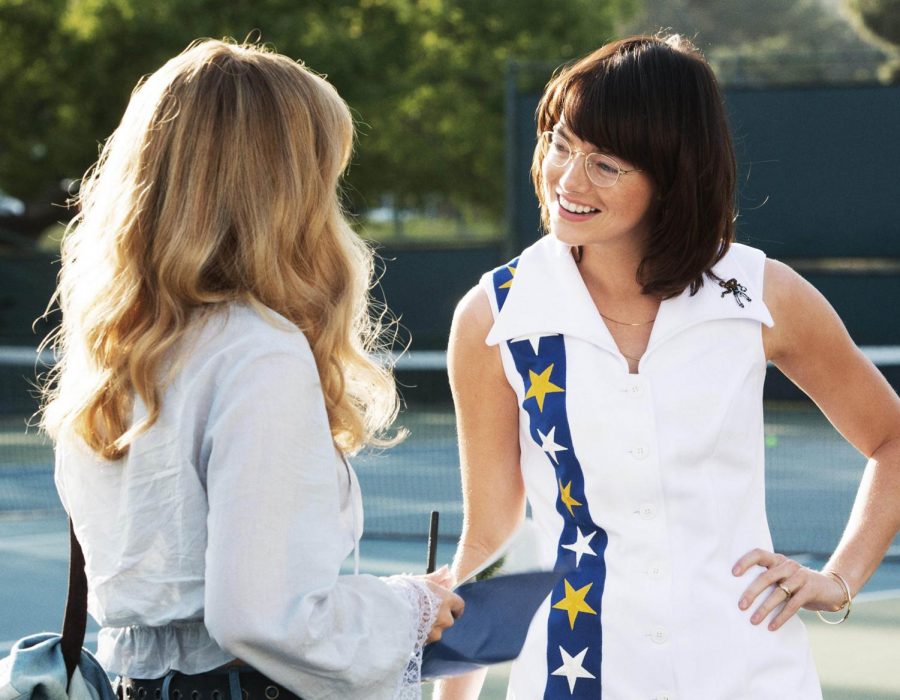New biopic serves up inspiration
“Battle of the Sexes,” starring Emma Stone, has received largely positive reviews from critics and currently an 85 percent approval rating on Rotten Tomatoes.
Oct 26, 2017
Forty-four years ago, an estimated 90 million people fixed their eyes on what would go down as one of the most famous tennis matches in history: the proverbial “Battle of the Sexes” between Billie Jean King and Bobby Riggs.
The enduring impact this matchup had on the treatment of female athletes — and women in general — can still be felt to this day.
And now, some four decades later, the real life drama that surrounded this iconic conflict serves as the inspiration for the new biographical sports film “Battle of the Sexes,” directed by Jonathan Dayton and Valerie Faris (“Little Miss Sunshine”).
The film, which stars Emma Stone as King and Steve Carell as Riggs, takes viewers behind the scenes of the highly publicized battle, shining a spotlight on much of the turmoil that took place off the court and away from the cameras.
Directing: 5/5
Although much of the appeal of “Battle of the Sexes” is rightfully rooted in its riveting real life story, the film also features some of the most visually stunning compositions to come out of a biopic in recent memory.
In particular, “Battle of the Sexes” benefits from a retro visual style that harkens back to the 1970s era in which the film’s fact-based story takes place. To achieve this, Dayton and Faris purposefully maintain a heavy use of film grain throughout the movie.
Consistently heavy film grain, along with subdued lighting and an appropriately postmodern color palette, result in a visual aesthetic that often makes the viewer feel like they’re watching an old home movie.
And fortunately, this nostalgic and retrofitted visual design is nicely complemented with ultra-modern cinematic techniques.
Dayton and Faris make full use of the tools in their directorial arsenal, utilizing mirror shots, extreme close-ups and crisply executed pans and tilts, among a host of other masterful editing tricks.
Compositional framing is especially strong in “Battle of the Sexes,” as Dayton and Faris deftly transition from aesthetically pleasing symmetrical shots to intentionally unbalanced compositions that effectively evoke the constant chaos and inner conflict that seeps into King’s personal and professional life.
Writing: 4/5
Adapting real life events to film can often prove to be a challenge, but thankfully, the screenplay for “Battle of the Sexes” largely succeeds at bringing its fact-based story to life without gross dramatization.
And yet, while “Battle of the Sexes” should be commended for its adherence to veracity, the film’s greatest strength is certainly its emphasis on the people at the center of the sports-based drama.
Indeed, “Battle of the Sexes” focuses less on tennis and more on the two central characters’ personal lives off the court. This particular narrative viewpoint makes for an entirely more emotionally affecting story — especially for King, whose internal and external conflicts comprise much of the film’s runtime.
In short, “Battle of the Sexes” is superior to most other biopics for its ability to humanize real-life people and transform them into fully developed and emotionally complex characters — rather than mere historical figures.
With that being said, there is still a handful of narrative shortcomings in “Battle of the Sexes” — namely, a few instances of overly sentimental and contrived lines of dialogue that slightly undermine the film’s otherwise constant commitment to realism and sincerity.
Acting: 5/5
In addition to a suitably retrofitted visual design and an emotionally affecting screenplay, “Battle of the Sexes” also benefits from some truly terrific acting.
Simply put, not enough praise can be directed towards the casting decisions for “Battle of the Sexes,” as Stone and Carell seem to have been destined to portray King and Riggs, respectively.
Stone is a particular standout in what is certainly one of the best performances of her career. As is usually the case for Stone, she brings an incredible amount of depth to her character, but she also undergoes a physical transformation. Altering her facial features and body language, Stone simply melts into King on the screen in an entirely convincing and committed portrayal.
Carell similarly assumes his character’s mannerisms but brings an added bounce of comedic buoyancy to his performance. By injecting some of the trademark goofiness that made Carell famous in his days as Michael Scott in the hit TV show “The Office,” Riggs is at once charming, charismatic and undeniably chauvinistic. In other words, he’s the character you love to hate.
Other standouts in the cast include Andrea Riseborough as Marilyn Barnett, the hairdresser with whom King falls in love, and Sarah Silverman as Gladys Heldman, King’s hilariously wry press agent.
Overall: 4.5/5
“Battle of the Sexes” is one of the most thoroughly enjoyable and genuinely stirring biopics in recent memory. Not only is the film a showcase for inspired performances and visually arresting camerawork; it’s also a necessary history lesson and reminder that our work towards true gender equality is far from finished.
Indeed, more than anything, the film informs us that when it comes to how we treat each other, regardless of sex, the ball really is in our court.


















